Featured Artists
Kirsten Aaboe (US), Willian Barela Costa (US), Susan Bercu (US), Marianne Bickett (US), Christina Conklin (US), Alison Lee Cousland (Australia), Yvonne C. Espinoza (US), Mark M Garrett (US), Michele Guieu (US), Marianela de la Hoz (US), Ellen Jewel (Scotland), Deborah Kennedy (US), Karey Kessler (US), Rosalind Lowry (Ireland), Suzette Marie Martin (US), Quin de la Mer (US), Mona Naess (Norway), Meredith Nemirov (US), Joseph Rabie (US), Priyanka Rana (US), Dorothy Ries Faison (US), Marcela Villasenor (US), Anita Wong (US), Eileen Wold (US).
This is the 11th What's next for Earth online exhibition based on the Think Resilience free online course by the Post Carbon Institute.
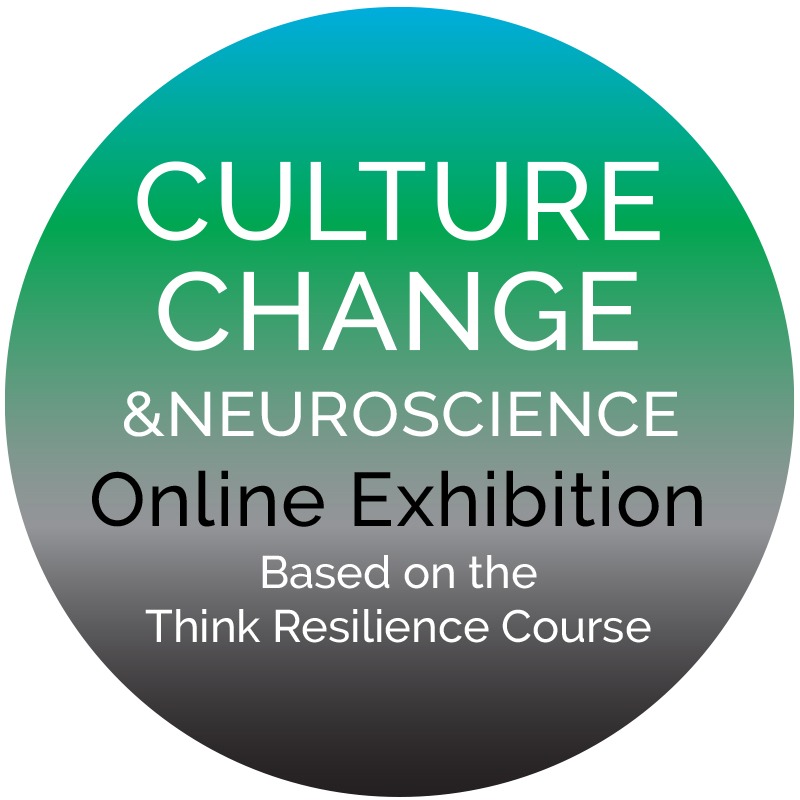 “If we want to adapt successfully to a future of less energy per capita, and little or no economic growth, we need to better manage some of the neurological traits that served our evolutionary forebears but are ill-suited to the modern world. Consumerism is a modern version of our biological drives for status-seeking and novelty-seeking and makes use of how our brain chemistry develops addictions. We also have an innate tendency to give more weight to present threats and opportunities than to future ones; this is called discounting the future, and it makes it hard to sacrifice now to overcome an enormous future risk such as climate change. Fortunately, we also have some inherited neurological tendencies that would be useful to encourage, like cooperation, empathy, and altruism.”
“If we want to adapt successfully to a future of less energy per capita, and little or no economic growth, we need to better manage some of the neurological traits that served our evolutionary forebears but are ill-suited to the modern world. Consumerism is a modern version of our biological drives for status-seeking and novelty-seeking and makes use of how our brain chemistry develops addictions. We also have an innate tendency to give more weight to present threats and opportunities than to future ones; this is called discounting the future, and it makes it hard to sacrifice now to overcome an enormous future risk such as climate change. Fortunately, we also have some inherited neurological tendencies that would be useful to encourage, like cooperation, empathy, and altruism.”
– Richard Heinberg
What’s Next for Earth is following the Think Resilience, the Post Carbon Institute’s free online course written by Richard Heinberg, one lesson per art call. To respond to the Shifting Cultural Stories art call, we asked the artists to signup and to watch the course, one lesson at a time:
Lesson 1: Introduction
PART ONE
Chapter One – Our Converging Crisis
– Lesson 2: Energy
– Lesson 3: Population and Consumption
– Lesson 4: Depletion (Resources depletion)
– Lesson 5: Pollution
Chapter two – The Roots and Results of Our Crises
We explore the role of human behavior in our sustainability crises, and dig deeper into where those crises are taking us:
– Lesson 6- Political & Economic Management (Social Structure)
– Lesson 7- Belief Systems
– Lesson 8 – Biodiversity
– Lesson 9 – Collapse
Chapter three – Making Change
– Lesson 10 – Thinking in Systems
– Lesson 11 – Shifting Cultural Stories
– Lesson 12 – Culture Change and Neuroscience
Each video is approximately 12 minutes long.
Think Resilience is hosted by Richard Heinberg, one of the world’s leading experts on the urgency and challenges of moving society away from fossil fuels.
We live in a time of tremendous political, environmental, and economic upheaval. What should we do? Think Resilience is an online course offered by Post Carbon Institute to help you get started on doing something. It features twenty-two video lectures—about four hours total—by Richard Heinberg, one of the world’s foremost experts on the urgency and challenges of transitioning society away from fossil fuels. Think Resilience is rooted in Post Carbon Institute’s years of work in energy literacy and community resilience. It packs a lot of information into four hours, and by the end of the course you’ll have a good start on two important skills:
1. How to make sense of the complex challenges society now faces. What are the underlying, systemic forces at play? What brought us to this place? Acting without this understanding is like putting a bandage on a life-threatening injury.
2. How to build community resilience. While we must also act in our individual lives and as national and global citizens, building the resilience of our communities is an essential response to the 21st century’s multiple sustainability crises.
Yvonne C. Espinoza
BOTH/AND (FOR QUINN)
Part of the Material Evolutions series. Repurposed costume jewelry and textiles on canvas.22”H x 18”W
Is the human super-power the ability to create the unnatural? The non-integrated or creation without consideration.
The artworld is always touching upon this topic of creation, sometimes with great consideration and other times (seemingly) not.
As artists, we have the ability to have a foot in two worlds. With one we create and build and with the other that is already in existence, we interact with our fellow world inhabitants. It isn’t always about the dichotomy: technology vs nature, man vs beast, civilization vs wilderness, modern vs ancient, etc.
There is that beautiful sweet spot that we can credit to artists and creatives. It’s a place where old wisdom, that has been cultivated from understanding the earth as a “partner”, gives rise to an appreciation for our earthly resources and their limitations.
Perhaps, it can even serve as the interwoven guiding principle toward a long-term appreciation of the world we leave for our children. A deeper legacy. And perhaps, a deeper love.
We artists humans can create beautiful things that nature did not. But, nature, long the staple spark of creative contemplation, give us the tools.
Instagram @ycestudios
©2022 Yvonne C. Espinoza
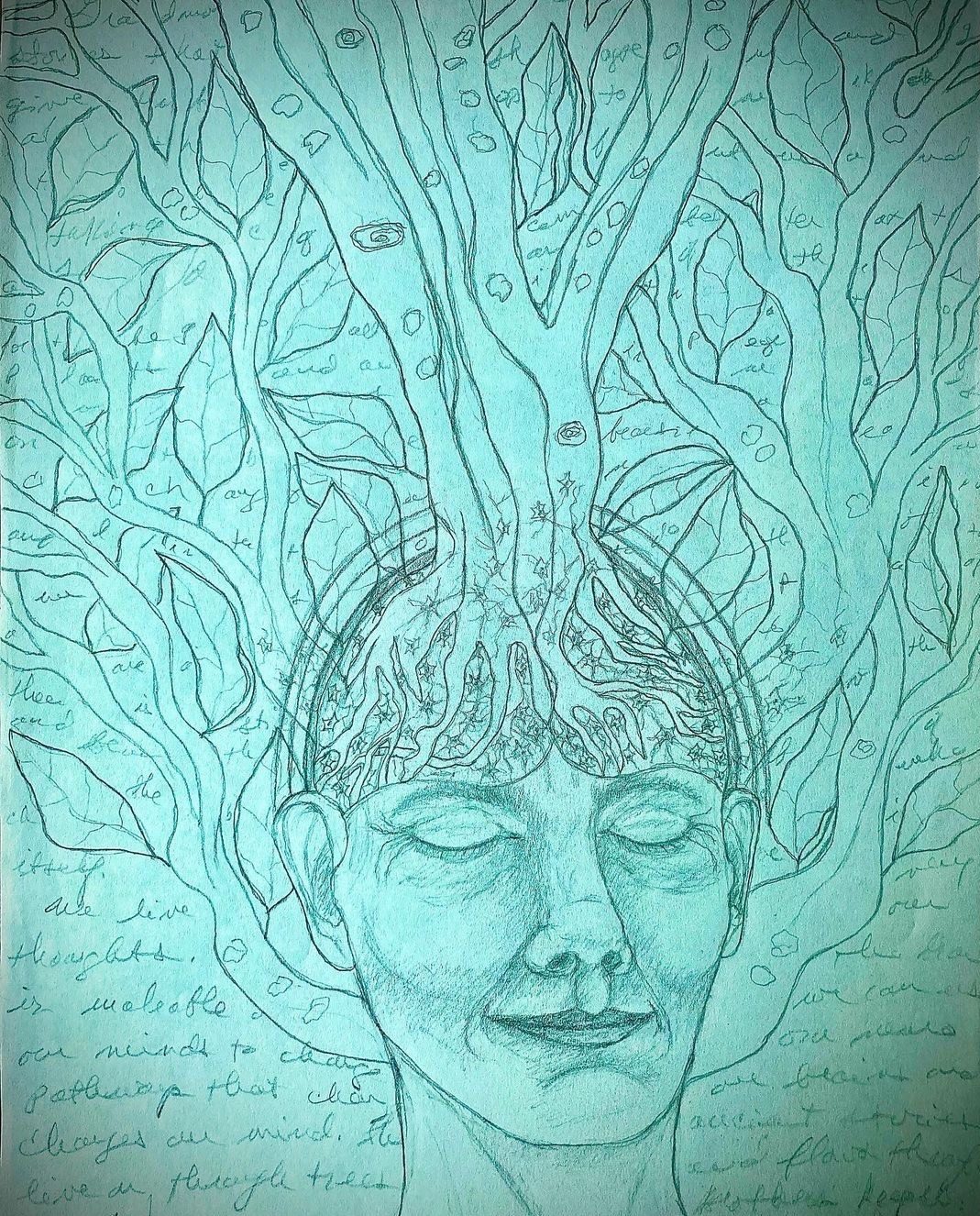
Marianne Bickett
RETHINKING: WE CAN CHANGE OUR MINDS (AND HAPPY EARTH DAY FELLOW EARTHLINGS!)
Recycled drawing paper and graphite pencil
Color added digitally
The current Art call, Culture Change and Neuroscience by Richard Heinberg of the Post Carbon Institute, focuses on the fact that “we humans are both selfish and sociable creatures.”
While selfish behaviors are deeply embedded into our hardwiring for survival, we learned over time to be cooperative and develop empathy also to survive. The neocortex, which is the “new brain” of mammals, has developed sophisticated mechanisms based on cultural stories. The amazing thing for me is that our brains are completely plastic, they can be changed by changing our thinking! “Neurons that fire together wire together” (Neurologist Donald Hebb) is how we can begin to reshape our habits and forge new relationships based on valuing our natural world. We often are too willing to endanger the future by engaging in greedy ventures that have short-term gain. If we can rethink our roots and reconnect to our precious planet and all the intelligent life here, there is hope of real change.
I was inspired by a handsome tree in our son’s backyard in Haleiwa, Oahu. This tree is clearly an elder with great wisdom and grace. I felt my mind connecting to its roots and a sense of communication with it. I thank the tree for its inspiration to show that we can change our minds to change our brains to change our minds. Thank you What’s Next for Earth.
Instagram @mariannebickett
©2022 Marianne Bickett
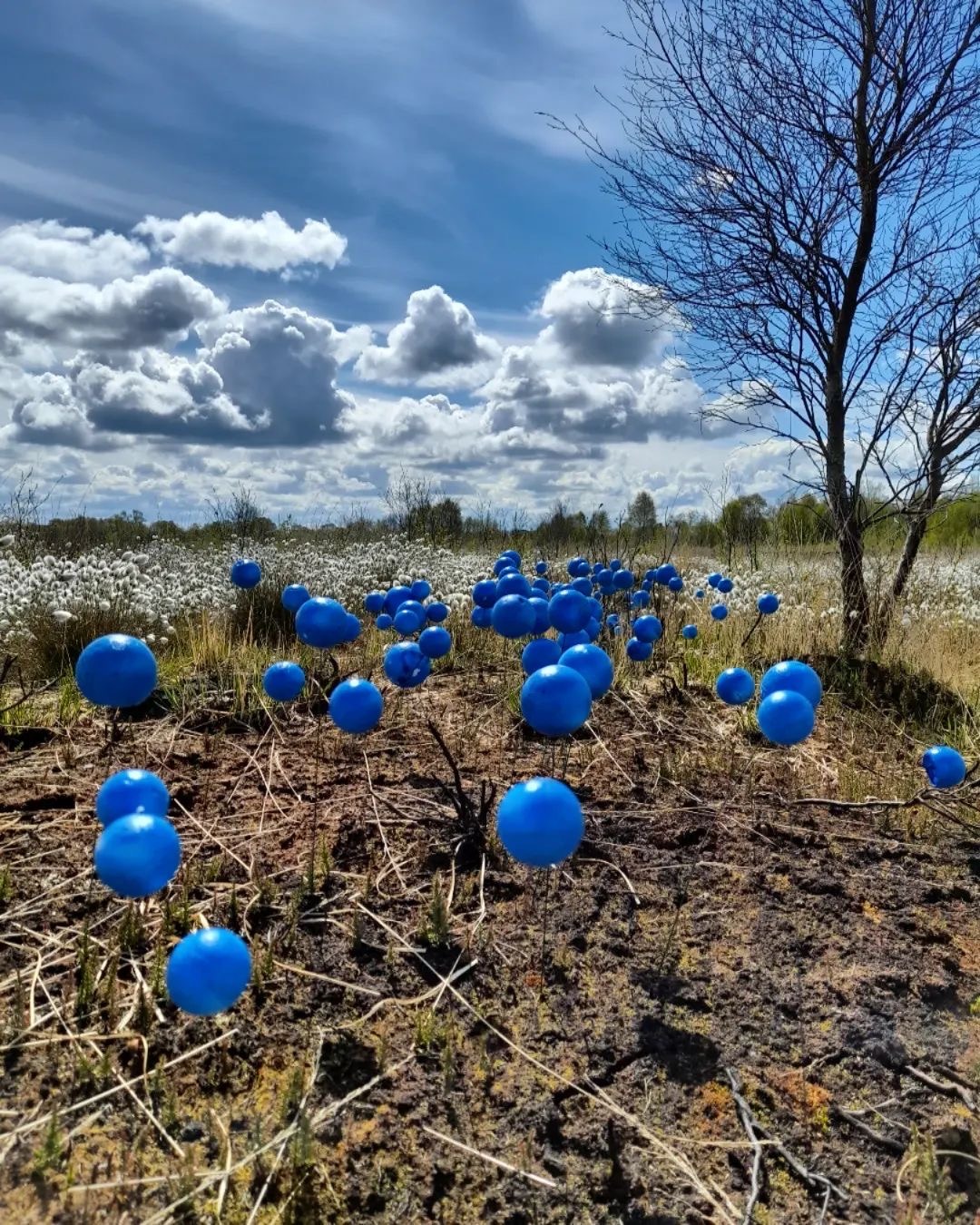
Rosalind Lowry
BLUE-EYED GRASS ON THE PEATLANDS OF IRELAND
Installation on the peatlands of County Tyrone
20ft x 40ft
This was an installation created as a response to the folk practices and traditions in Ireland on peatlands, and their commodification. It relates to the theme of Culture Change and Neuroscience in relation to the treatment of these special areas, and family ownership of ‘plots’ through generations There is a current very slow shift of thinking about the use of these endangered places. For 2 years I was Artist in Residence on the peatlands for the UK Heritage Lottery, creating work in response to the community connection to the land.
Instagram @rosalindlowry
©2022 Rosalind Lowry
Mona Naess
WE ALL WANT MORE, BUT WHAT IS «MORE»?
Digital photo/video collage
I think a lot about what makes me happy now, and what made me happy before.
“Can we rewire our brains to some degree through the formations of new habits?”
I think so.
“New behaviors: sharing, giving, conserving, healing and thriving within constraints.”
I’m trying a few small steps in that direction at least.
Instagram @mona_naess
©2022 Mona Naess

Susan Bercu
WENDY AND MICHAEL
Wall assemblage uses largely recycled materials, adhered with string, wire, glue, and nails. 26 in. wide x 25 in. high x 10 in. deep
My latest Window in my Stick Stories series, created mostly from driftwood, implores us to observe and revere nature. The eye glued into the driftwood profile (located on the bottom branch) is a broken Obsidian arrowhead etched with tiny chisel marks. It was found in the creek just 30 feet from my home where wildfires and floods between 2017 and 2021 unearthed these remnants from the Coast Miwok who settled here in Sonoma County 1500 years ago.
For our civilization to survive, the Post Carbon Institute’s chapter on Culture Change and Neuroscience teaches, “Most traditional human societies expended a great deal of effort to provide moral guidance, often through myths and stories, to foster pro-social behavior.”
This eye is a talisman, reminding us that we must live in harmony with each other and with nature.
Details: Pierced metal face influenced by Milagros (miracle charms found in Latin cultures); head of a giraffe represents endangered wildlife; head of a tribesman represents indigenous cultures.
Instagram @susan_bercu
©2022 Susan Bercu
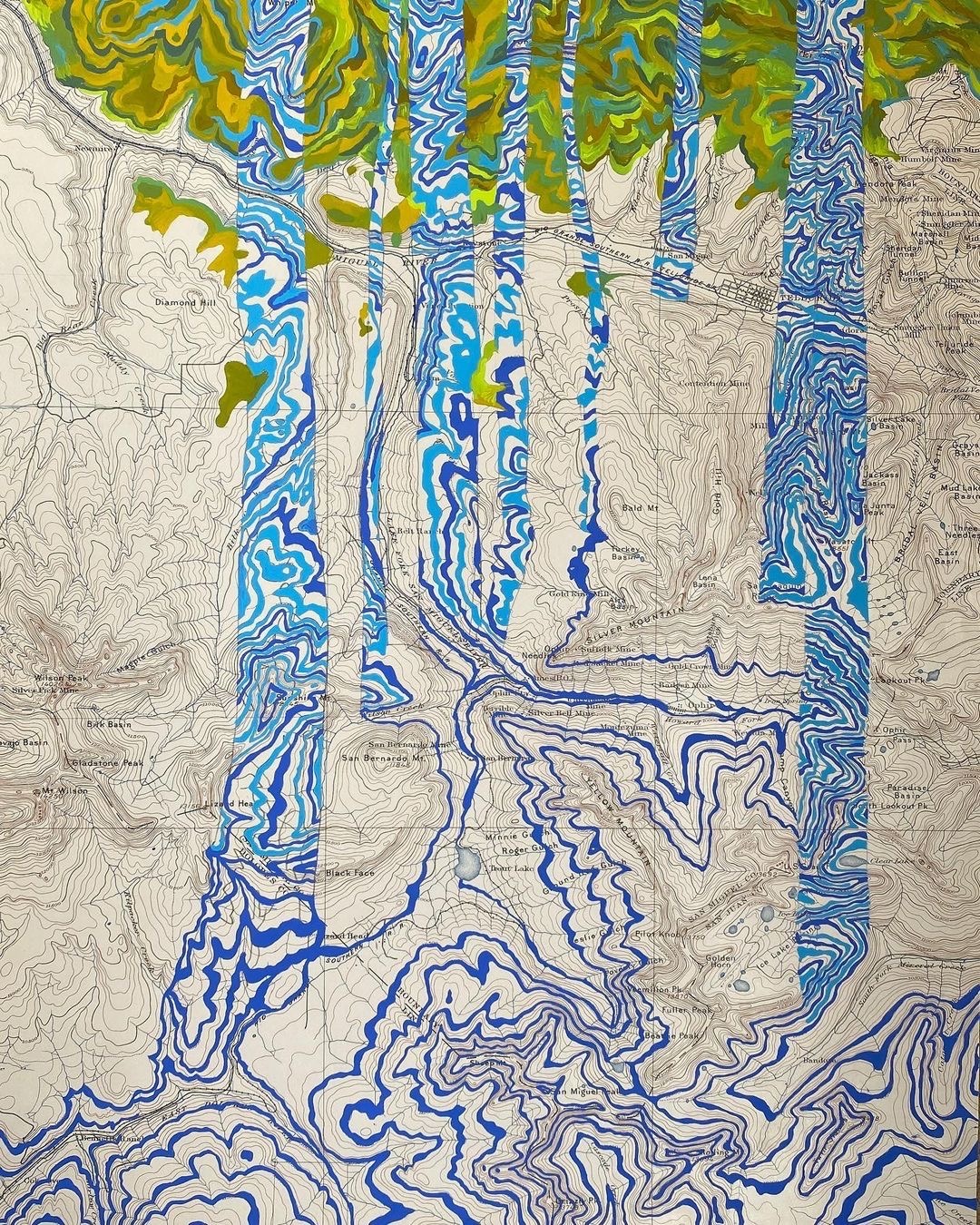
Meredith Nemirov
WHEN WATER SLIPS THROUGH ROOTS
Acrylagouche on a recycled topo map
13.5″ x 17″
This line is from a poem titled Anvil by Arthur Sze “when water slips through roots, rises through a trunk, streams into trees”.
I am always fulfilled and excited to look at the way the natural world works to sustain its life and nourishing presence on this earth. There is a lot to learn about the economy of consumption.
The sleek interdependence which sustains trees, plants, and other forms of wildlife on earth would be a good model as we go forward and try to reduce our habits of excessive consumerism.
Not only is the process of survival or existence in the natural world vital but the result is also incredibly beautiful and sensual, attributes all humans appreciate and can enjoy in ways other than the acquisition of more material goods.
Instagram @meredith.nemirov
©2022 Meredith Nemirov
Karey Kessler
FROM THE STILLNESS AND FROM THE THUNDER
watercolor on paper
3’x8′, 2020
My work explores the entangled ways in which our minds, time, and place are deeply interconnected. Using the imagery of cartography, I create a network of thoughts about the climate crisis, the expanse of geologic time, and the vastness of the cosmos.
Instagram: @kareykessler
©2022 Karey Kessler
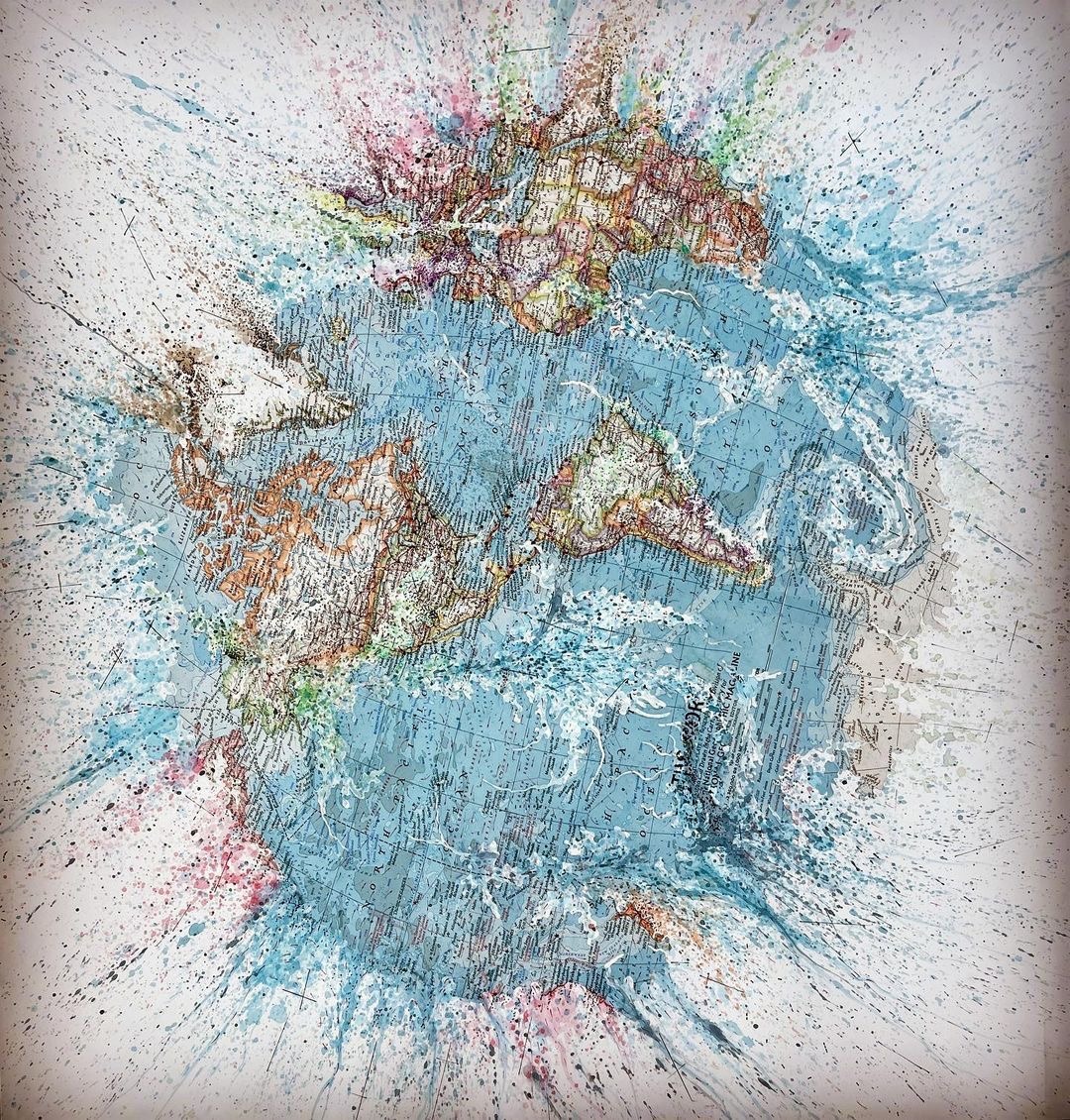
Mark M Garrett
WORLD APART
Cut map collage & watercolor
23”x22.5”
2021
Instagram: @markmgarrett
©2021 Mark M Garrett
Alison Lee Cousland
THE YOUTH OF TODAY AND TOMORROW.
Most traditional human societies expended a great deal of effort to provide moral guidance, often through myths and stories, to foster pro-social behavior. When a culture ceases providing this needed educational effort ~ Values of self-restraint and cooperation, empathy and altruism can become seriously eroded. ~Richard Heinberg.
This piece features my second set of brushes made with all-natural materials: Seed pods, hemp yarn, reused tissue paper, and smoked paper. The charred handles were made from pieces of burnt branches, that I’d found on the ground in the aftermath of bushfires in the Killara bushland in the Garigal National Park.
The text on the burnt paper:
The youth of today came with a code of knowledge that has never existed before upon Planet Earth. ~The Only Planet of Choice. Phyllis V. Schlemmer.
Being born into a society that is so alien to what would be their innate connection to the natural energy and beauty of Earth and its relationship to the entire cosmos: The youth of today are either strongly mesmerized by modern technology and must have the latest ‘gadgets’ or like the Indigo, Rainbow and Chrystal children know they have a totally different purpose to fulfill on Planet Earth.
My work reflects my personal need to nurture and protect the natural world and the consequent adoption of new approaches to art-making that seek an active partnership with nature.
I feel that using natural and discarded materials is such a small act of protest against our throw-away culture, but it’s a step towards making a difference in the world the ‘youth of tomorrow’ will face.
Instagram @allyinspirit.gridofnine
©2022 Alison Lee Cousland
Anita Yan Wong
LEAP
Ensemble of “Contemporary Traditional” ocean awareness paintings using ink, minerals, and real plastic bottles and plastic byproducts (sun printed onto the canvas) collected near the local beach.
These environmental awareness paintings reflect our human selfishness and altruistic inherited behaviors. We have consumed and produced so much plastic, directly harming ocean animals and sea crops. We must end this toxic cycle by rethinking for a cultural change.
The project reflects our human addictions, overconsumption, and plastic pollution in our current time. Traditional Asian painting often features beautiful and calm landscapes and animals, these “Contemporary Traditional” paintings are once again speaking for mother nature. “Mother Nature can’t speak for herself verbally but She is whispering to us daily.”
Instagram: @anitayanwong
©2022 Anita Yan Wong
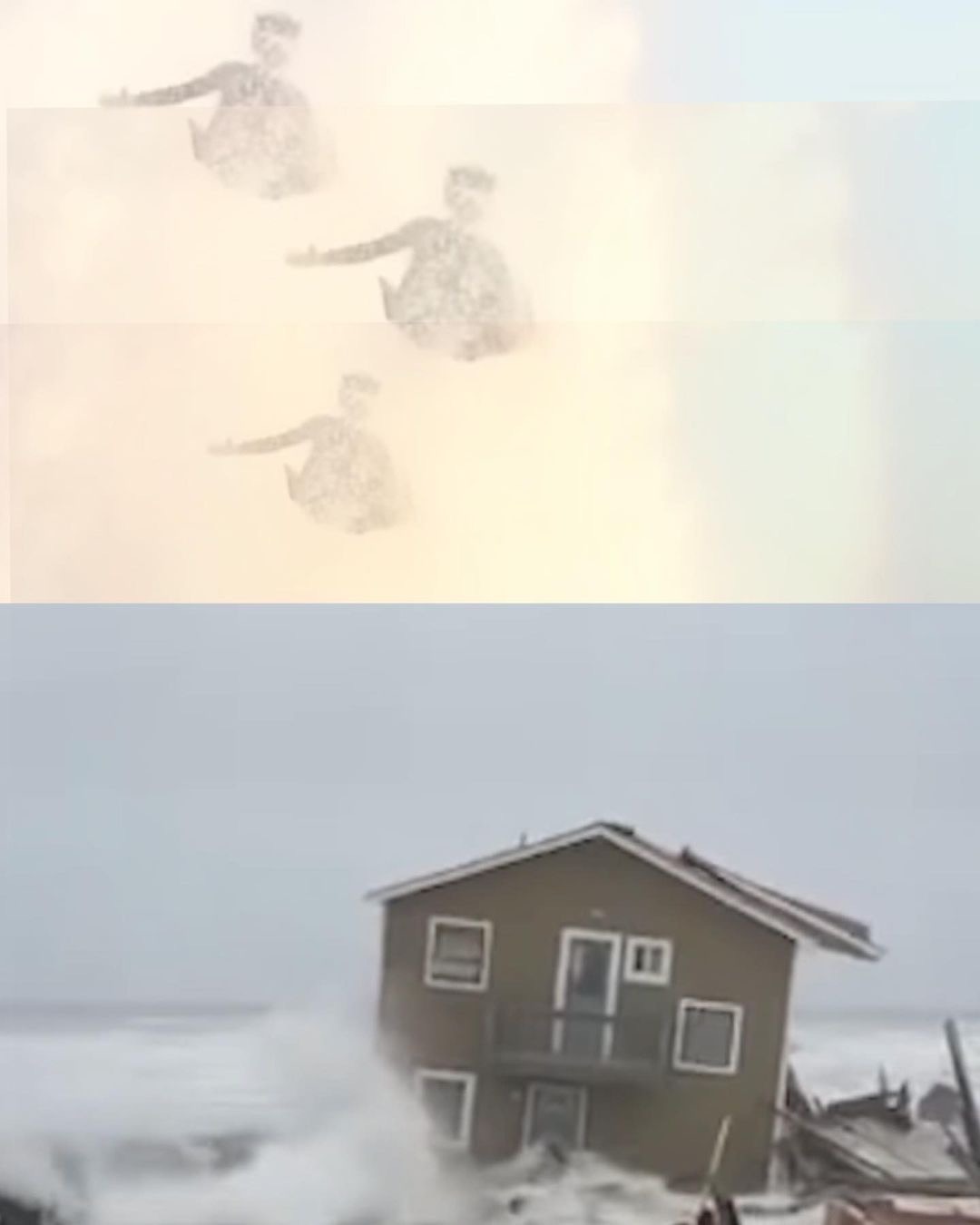
Kirsten Aaboe
FREE FALL AT A COST
digital photo collage
Free Fall is the state I’m in these days, sometimes, though I try to deny it. My neural pathways, geared toward achieving pleasure, escaping pain or suffering, guaranteeing reward are in need of constant reorientation.
Community, shared support, empathy and compassion help me reorient, come back to earth, live in awareness of what I use, and try not to abuse. I remember when chasing the next thing – filling the hole in my psyche with stuff – revealed itself to be the wrong way to get “there,” but riding that wave, buying that house, being applauded, and holding onto the means to keep those things is all so hard to reverse. Quiet helps.
Instagram @kitaaboe
©2022 Kirsten Aaboe
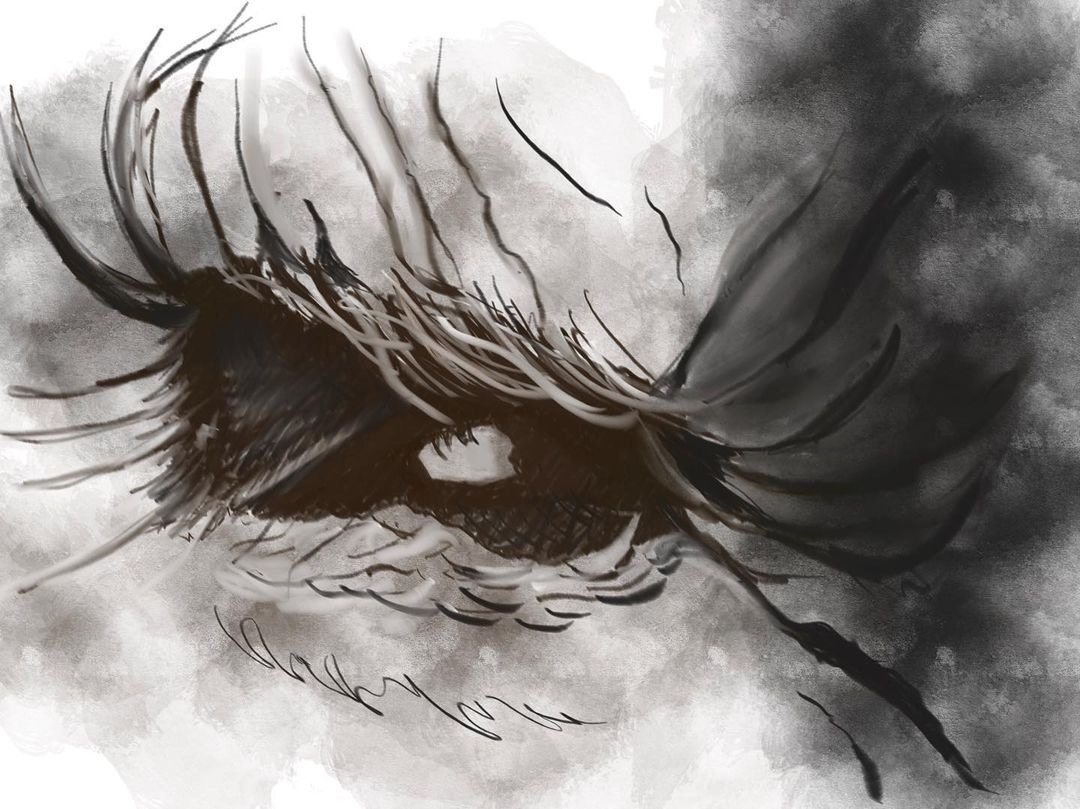
Kirsten Aaboe
OUR FUTURE? TOGETHER? THE LONG VIEW
Charcoal and ink on paper
The old people, our elders, animals, plants, and all living things, are in a community, connected, physically and spiritually. Rushing headlong for the precipice, consuming, discarding, never looking at the trail of refuse behind us, won’t be possible much longer, since the circle is being closed. Life is to cherish.
Instagram @kitaaboe
©2022 Kirsten Aaboe
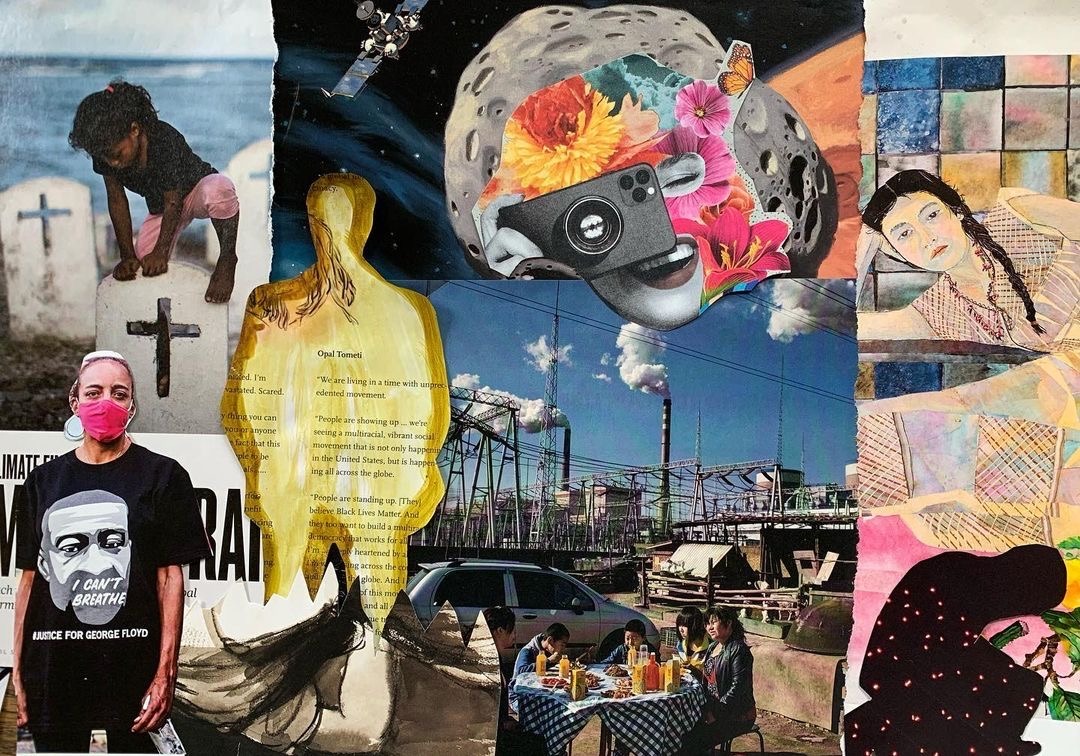
Christina Conklin
COLLAPSE COLLAGE: NEUROSCIENCE AND CULTURE CHANGE
14” x 10”, 2022.
For the bimonthly #whatsnextforearth art call, I was thinking about power — who has it, who doesn’t, and why. Somewhere between consumption, boredom, and survival is a field where we can meet, “out beyond ideas of right-doing and wrongdoing,” as Rumi said. “When the soul lies down in that grass, the world is too full to talk about,” he writes. “Ideas, language, even the phrase ‘each other’ doesn’t make any sense.” I was feeling pretty judgemental when I made this collage, but I notice now that the man is empty, and that inside it says “I’m scared.” Humanity is hurting—and hiding— and the only road through is compassion and lovingkindness. I truly believe this on my good days.
Instagram @bychristinaconklin
©2022 Christina Conklin
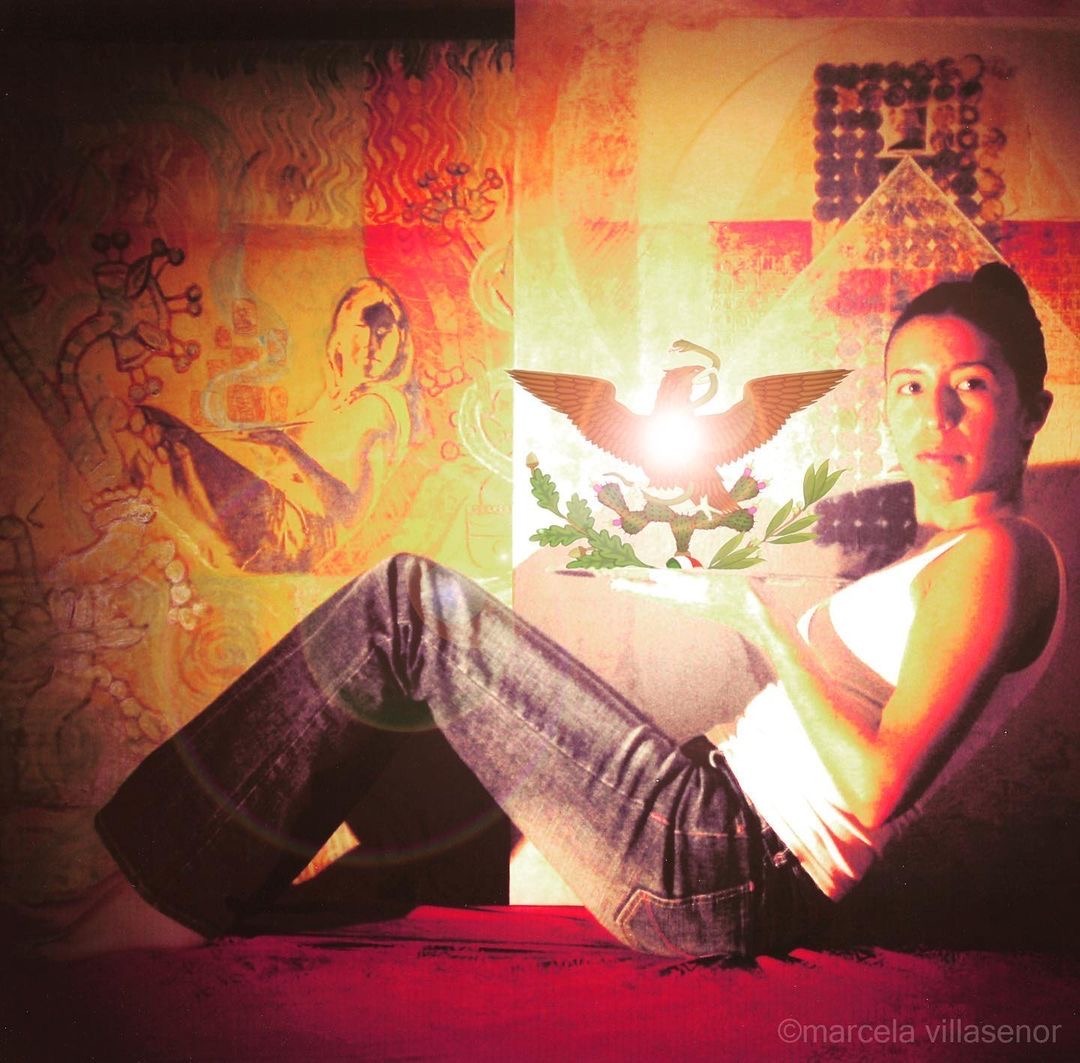
Marcela Villaseñor
CHACMOOL OFFERING A NEW CULTURE WITH CONSTRAINTS “THE 4.A T”
2004-2022, digital collage
“Creating new cultural stories in which high status and reward are attached to habits and behaviors that promote healing, sharing, giving, creating, growing, conserving and thriving within constraints?” Richard Heinberg
La 4.a Transformación de México por AMLO, plantea 20 principios:
Del respeto a la diferencia. De la vida . De la dignidad. De la libertad. Del amor. Del sufrimiento y el placer. Del pasado y del futuroDe la gratitud. De la gratitud. Del perdón. De la redención. De la igualdad. De la verdad, la palabra y la confianza. De la fraternidad. De las leyes y la justicia. De la autoridad y el poder.Del trabajo. De la riqueza y la economía.De los acuerdos. De la familia. De los animales, las plantas y las cosas.
“The 4th Transformation” of Mexico from AMLO It raises 20 principles:
From respect to difference. From life. of dignity. Of freedom. of love Of suffering and pleasure. Of the past and the future Of gratitude. Of gratitude. Of forgiveness. Of redemption. Of equality. Of truth, word and trust. From the fraternity. Of the laws and justice. Of authority and power. Of work. Of wealth and economy. Of agreements. Of the family. Of animals, plants and things.
Instagram @mvillasenor
©2022 Marcela Villaseñor
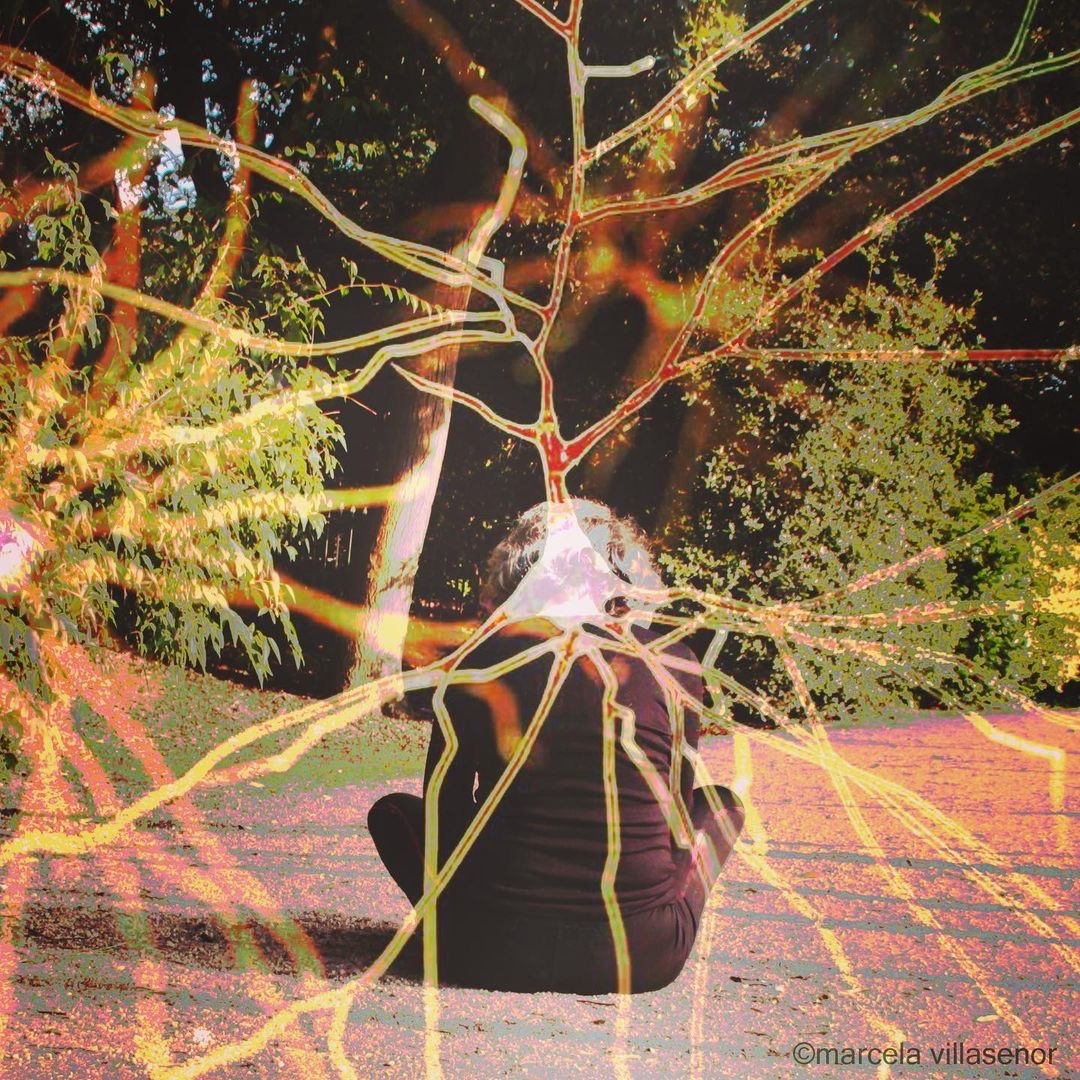
Marcela Villaseñor
REWIRE YOURSELF
2022, digital collage
“We humans are both selfish and sociable creatures. If we want to adapt successfully to a future of less energy per capita, and little or no economic growth, then we might be better off with a little more sociability and a little less selfishness.” Richard Heinberg
Instagram @mvillasenor
©2022 Marcela Villaseñor
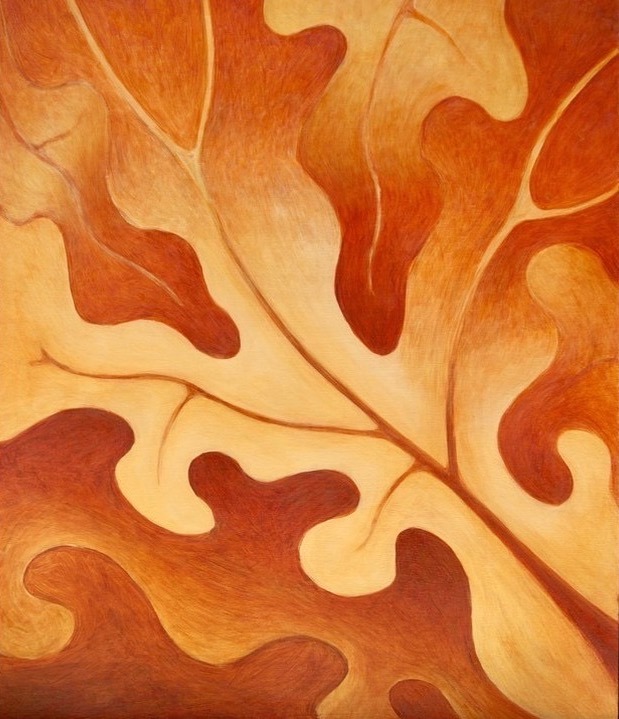
Deborah Kennedy
O GEO NEO NEURO
Materials: pigment, medium, board, earth, 30” x 48” x 2”
This painting depicts an electron microscopic image of a slice of the human brain with earthen side panels. It is my meditation on what I see as the core of our environmental problems—our own minds, our own ways of thinking, and the acute challenge we face to change our mentalities. Cooperative behaviors are valued in our societies, but often only in limited ways and often focusing on a relatively small circle of people.
The actions we take in the larger world often seem primarily guided by selfishness, insatiable greed and unrelenting desire to consume. These drives are often invisible to us and every form of destruction we are carrying out, whether against the larger natural world or other humans often seems like the normal or justifiable business of the day.
The pandemic could be a valuable period to learn important ecological realities, for example, we now know every person is intimately connected to the rest of the life on the planet, and if we don’t foster a healthy world for all people and life forms we will be increasingly vulnerable on many fronts. Can we use our creativity to create new symbols and stories that help us envision the realities of our deeply connected world?
Instagram @deborahkennedyart
©2022 Deborah Kennedy
Mona Naess
MAKE THE INVISIBLE VISIBLE, PLEASE
Bronze sculpture 27/28/31 cm, 12 kg
This sculpture was created several years ago in response to our over-consumption, climate change, and the connection between the earth and pleasure. We love to enjoy and consume, but what nourishes beauty EARTH is getting sicker and sicker every day.
Today, the sculpture is equally relevant to the theme of Culture Change and Neuroscience in relation to a desired change in our reward and motivation system and addictions to quick rewards.
Instagram @mona_naess
©2022 Mona Naess
Quin de la Mer
CICADA TRANCE/FIRE DANCE
Sound Art and Moving Image, July 2021
Considering Richard Heinberg’s discussion concerning our biological drives that support addictive behaviors like consumerism, I am interested in making artwork that pairs unifying states of consciousness and subconsciousness with the desire to connect and empathize with the more than human residents we share this world with. Moreover, to find fulfillment in activities that do not involve consumerism while feeling disgust for consumer behaviors. The artwork I created several months ago is a start.
I created this sound piece during the massive Cicada Brood X hatching that occurred in Kentucky (and beyond) in 2021. Using field recordings of the three Brood X varieties I spun them through an electronic program playing their sounds at C-1 (brain wave states correlate to sound, C-1 being Gamma = unifying consciousness). Next, I created a series of percussion loops at C-2 (Theta wave states = shamanic drumbeat/sleep transition). Last, I made a breathing loop at C-3 (Delta, deep sleep/heartbeat). I put them together to create a musical trance piece meant to be set on loop for extended listening and paired it with a moving image of a fire.
Instagram @i3rstudios
©2022 Quin de la Mer
Priyanka Rana
STING
Gold plated bronze
2021
This sculpture is an abstract form of a bee. I chose this form for its complex structure and for the delicate balance that bees represent in our environment. The sculpture has a highly reflective surface and mirrors its surroundings.
Much like how nature prompts us to reflect on ourselves, on what shapes us, and allows us to understand the impact of our actions.
With each seasonal cycle, we witness the growth that is a testimony to harmony and survival. As we rebuild with the advent of a new cycle (post-pandemic), our systems of growth need to assimilate this crucial interplay that enables the subsistence of all, big and small.
Instagram: @priyankarana_artist
©2021 Priyanka Rana
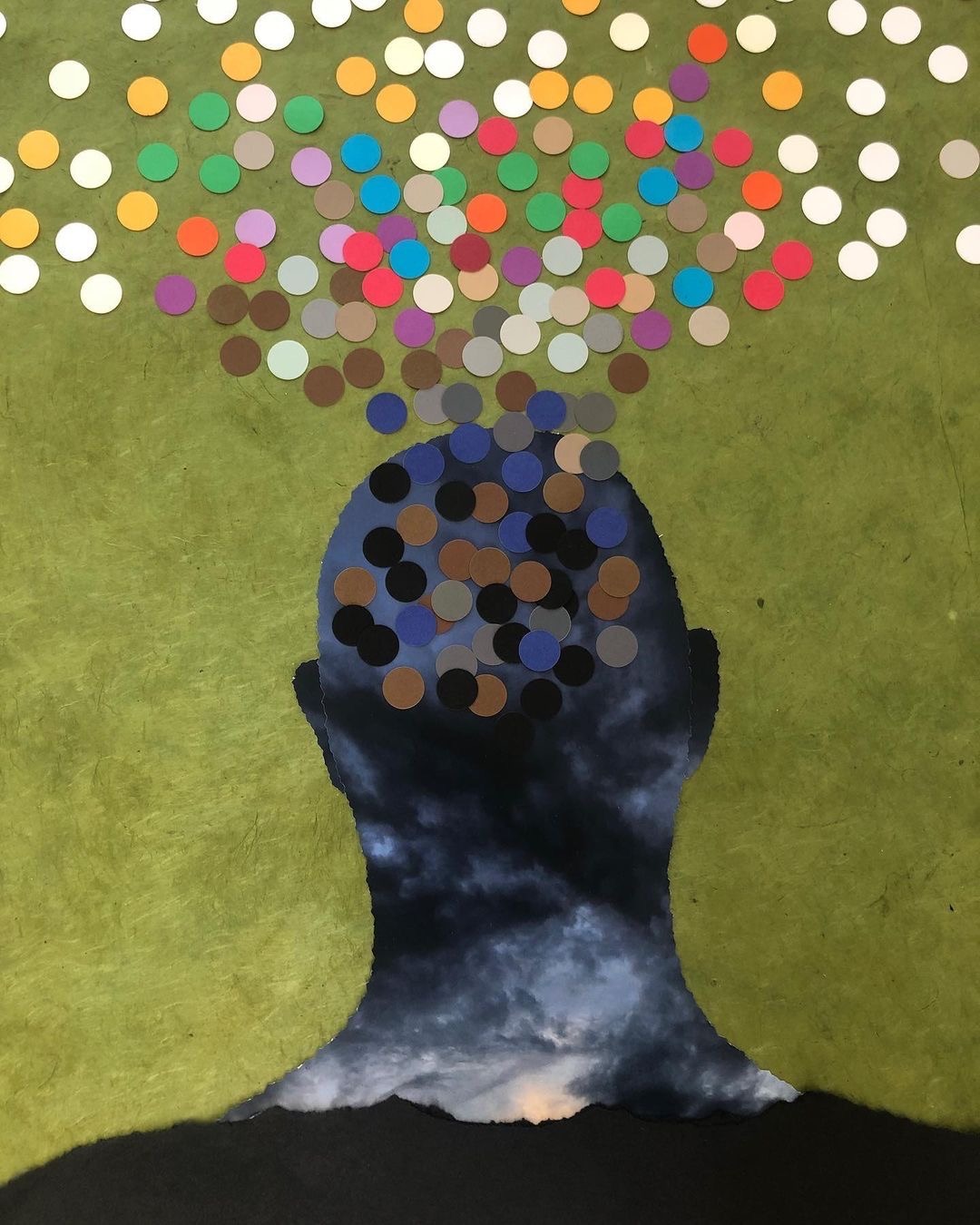
Michele Guieu
WHAT DOES SUCCESS MEANS IF WE WANT
TO KEEP A HABITABLE PLANET?
Ephemeral composition
Paper, print on paper of a photograph taken on the Pacific Coast close to Santa Cruz (from a series of older prints that I am keeping), paper dots from a previous project. 19”x25”
Our chance to live on a habitable planet depends on our capacity to shift from destructive dreams to regenerative ones. This quote from the lesson particularly resonates with me:
“All in all, if we’re going to achieve deep cultural change we face some hefty obstacles. We’ll need to find long-term ways to heal our culture so that it once more teaches self-restraint and empathy. Over the short term, we probably can’t change people’s tendency to want more. But we can define what “more” means. Richard Heinberg
Instagram @micheleguieu
©2022 Michele Guieu
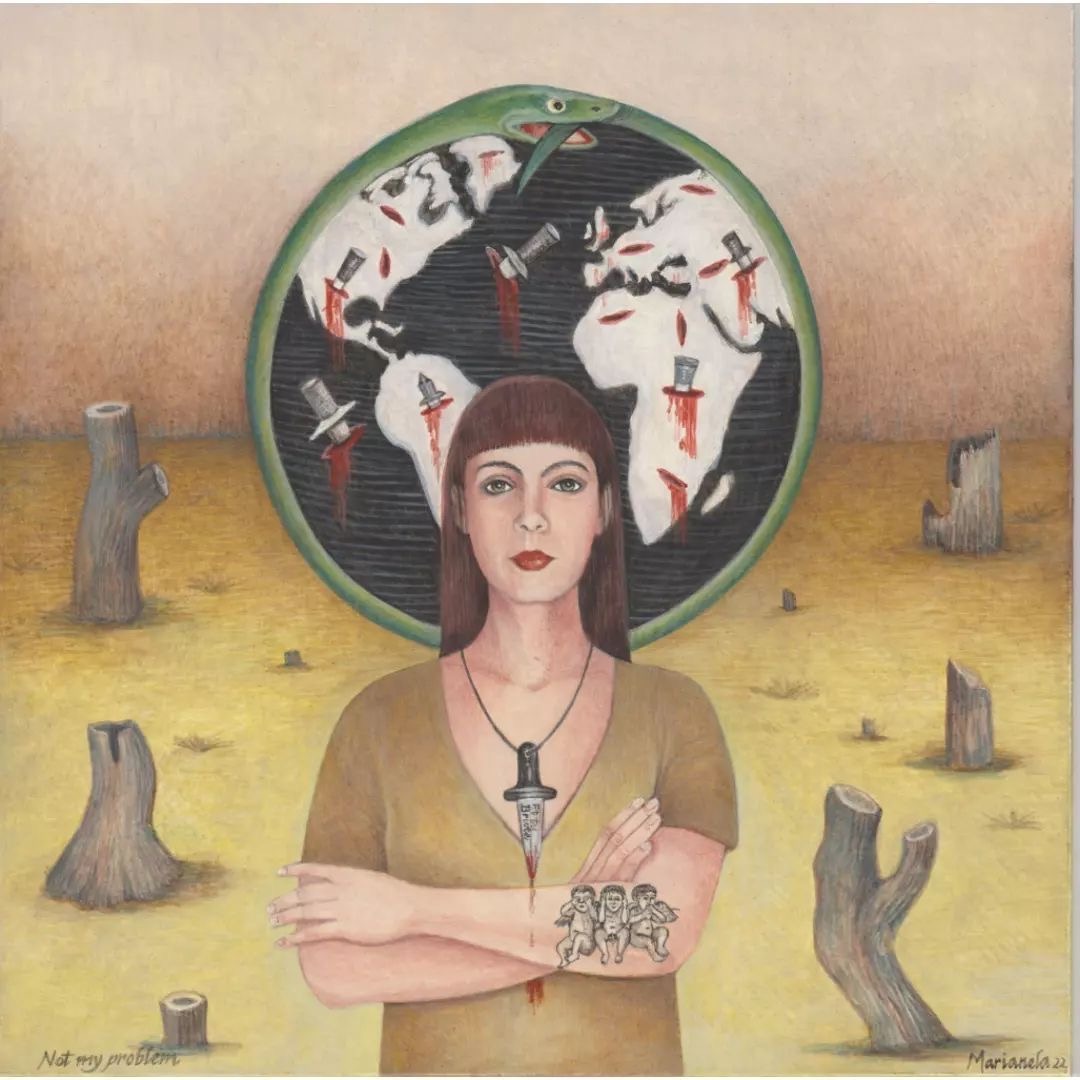
Marianela de la Hoz
NOT MY PROBLEM
NO ES MI PROBLEMA
Egg tempera on board
8 x 8 in.
We need to change there is no time to remain indifferent, let us see, listen and speak out.
Instagram: @marianeladelahoz
©2022 Marianela de la Hoz
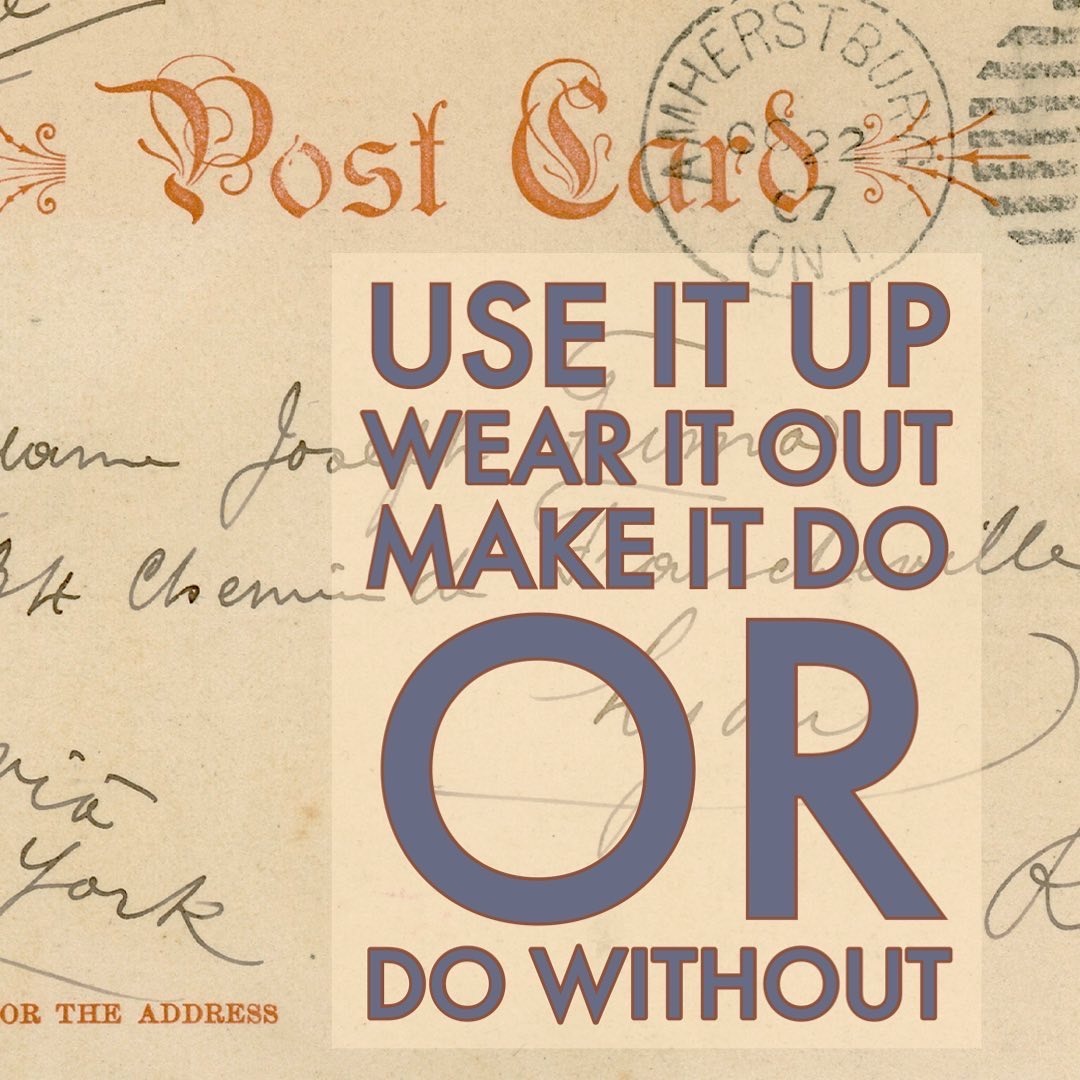
Suzette Marie Martin
1943-44 archival ads from the US War Advertising Council.
Digital re-design of a WWII slogan.
Large corporate entities are responsible for most of the current climate and ecological crises. But individuals can still play a part to help preserve diminishing resources.
During World War II, every aspect of American life was refocused during a period of rationing and limitations of material goods.
“Use it up, wear it out, make it do, or do without” was a popular saying promoted through government ads designed to make everyone feel as if they were contributing to the war effort. Our great-grandparents ( or grandparents) were proud of their frugal, creative, DIY, and thrifty lifestyles that wasted nothing!
Today repurposing, re-using, repairing, and up-cycling becomes more and more essential as strained ecosystems and finite resources make excessive consumption and single-use products less and less sustainable.
The Post Carbon Institute, “Think Resilience Course” states: “Consumerism hijacked our brains’ reward pathways for status and novelty, and it has also deliberately eroded our learned social adaptations for restraint and empathy. It reduced the perceived social value of thrift and sacrifice on behalf of the community in order to promote the ideal of individual gratification through consumption.”
Instagram @szttmrtn
©2022 Suzette Marie Martin
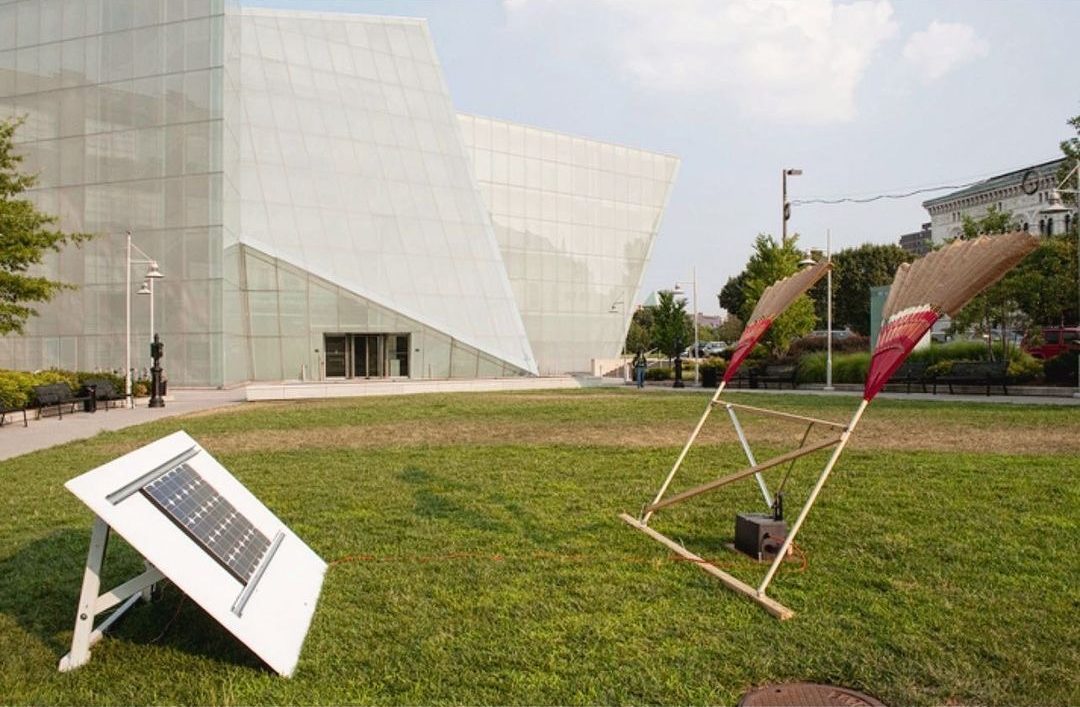
Eileen Wold
FAN BEARER
This sculptural work built in collaboration with an engineer combines a windshield wiper motor, repurposed solar panel, and old rakes I turned into fans with recycled paper that slowly lower to “fan” passers-by.
An older work but the first thing that came to mind when reading the latest essay from the Post Carbon Institute -what’s next for earth art call. “Culture Change and Neuroscience”
As the pharaohs once were cooled by manpower, the American capitalist culture expects unprecedented amounts of comfort and gratification at any cost to our environment. We tear down mountains in West Virginia to mine coal to make electricity only to waste it on making ice cubes to cool our drinking water or to light up a billboard in Times Square.
How can we reflect the true cost of consumption?
Instagram @eileentwold
©2022 Eileen Wold
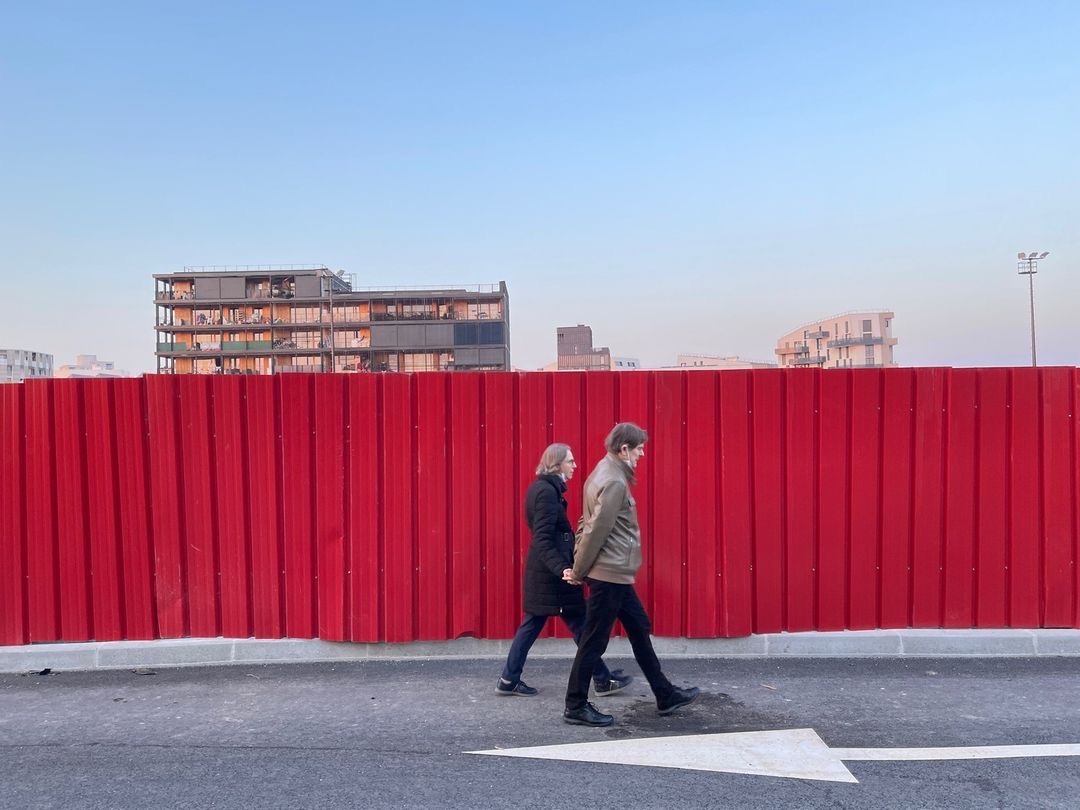
Joseph Rabie
LE CONTRESENS DE LA VIE
Digital photograph, iPhone 12
The title cannot readily be translated into English. The French “le sens de la vie” is “the meaning of life.” A “contresens” is a misinterpretation or misrepresentation. But it also refers to going the wrong way down a one-way street.
The photograph shows an environment that is wholly mineral: asphalt, metal, concrete, and glass. It is the Boissière-Acacia housing estate, under construction in the Parisian suburb of Montreuil. It is a world from which all vegetation appears to have been extirpated.
A million signs surround us, warning us that we have to turn around and go in the opposite direction, that our current way of life is leading to our undoing. The arrow in the road points this out without any ambiguity. Yet our brave couple grasp hands and march stolidly on as if the program running in their heads tells them that everything’s gonna be all right, everything’s under control, and besides, dealing with future misery is not worth sacrificing the present’s good life.
Instagram: @joseph.rabie
©2022 Joseph Rabie

Ellen Jewel
NATURE FIRST
Digital Art done with Procreate
2048 x 2048 px
I stepped out of my comfort zone here, which was long overdue, and painted a skin color that is not my own! It’s time I gave others representation in my art instead of continuing to add to the western whitewashing normality.
I have been surrounding myself with the thought recently as my houseplants are producing babies and need caring for and it’s time to plant seedlings outdoors to provide us with crops later in the year. We play a huge part in how nature provides for us, we can handle it all with love and care together, in hopes of a brighter and plentiful future, OR we can continue to take and take and take until there is nothing left but a ruin of what we could have been. Which sounds more appealing in the long run?
We’re all in this together. Together is the only way we can change.
Instagram: @_jewels_art_
©2022 Ellen Jewel
Technodruidism
TECHNODRUIDISM [collective]
The artistic piece was made to be explored as people find its parts interesting, as blocks of subjects.
Technodruid design is our neuroartistic artifact. We drew a line of provocation and possibilities not only to reframe the interaction of plants with humans but to suggest a future in which we could feel plants; forests; animals and the planet more closely. The human being has mirroring; imitation and empathy skills, but these are neural circuits that need to be trained.
We are a group that likes open science and biohacking. Our initiatives and labs: @_hackvi_ e MagnusLab
Rio de Janeiro, Brazil
Instagram: @technodruidism
@willbcosta
@camilacristane
@isabellamessut
©2022 Technodruidism
Dorothy Ries Faison
THE DOPAMINE GRINDER
Collage of found ripped lottery tickets in Siorac en Perigord 2022 with charcoal and watercolor on paper
100 x 70 cm
2022
Instagram: @ riesfaison
©2022 Dorothy Ries Faison
What’s Next For Earth is an art project created in March 2020 by Michele Guieu, eco-artist, and MAHB Arts Coordinator, to understand the human predicament and reflect on the climate emergency in order to take action. The project is supported by the MAHB and the Post Carbon Institute. If you have any questions, please send your message to michele@mahbonline.org.
Thank you ~

